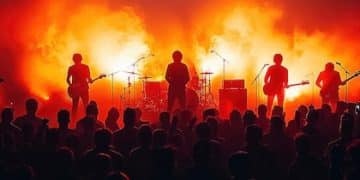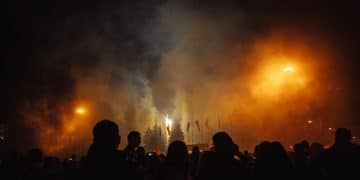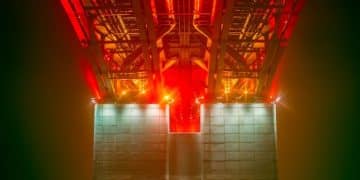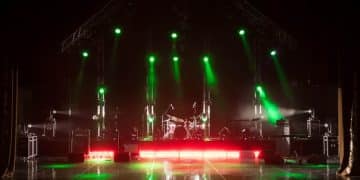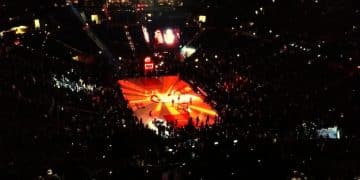Concert Photography Secrets: Heavy Metal in Low Light (2025 Edition)

Concert Photography Secrets: Capturing Stunning Heavy Metal Performances in Low Light (2025 Edition) delves into essential techniques and gear choices for photographers aiming to master the art of shooting high-energy heavy metal concerts in challenging lighting conditions, ensuring captivating and memorable images.
Unlocking the secrets to capturing breathtaking heavy metal performances in dimly lit venues is an art form. This guide, Concert Photography Secrets: Capturing Stunning Heavy Metal Performances in Low Light (2025 Edition), provides the essential knowledge and techniques for photographers of all levels to master this exciting field.
Essential Gear for Heavy Metal Concert Photography
Gearing up for a heavy metal concert shoot requires careful consideration. The right equipment can make the difference between capturing stunning images and struggling with blurry, underexposed shots. Let’s explore the essential gear you’ll need to succeed.
From choosing the right camera body to selecting the perfect lens, understanding your equipment is paramount. We’ll also delve into the importance of accessories like memory cards, batteries, and earplugs.
Camera Body Considerations
A camera body with good high ISO performance is crucial. Look for models that minimize noise at ISO 3200 or higher. Full-frame sensors generally excel in low-light situations compared to crop sensors.
Lens Selection
Fast lenses with wide apertures (f/2.8 or wider) are essential for gathering enough light. Zoom lenses like a 24-70mm f/2.8 or a 70-200mm f/2.8 offer versatility, while prime lenses like a 35mm f/1.8 or 50mm f/1.4 can provide even better low-light performance and shallower depth of field.
- High ISO Performance: Prioritize camera bodies known for minimal noise at high ISO settings.
- Fast Aperture Lenses: Lenses with apertures of f/2.8 or wider are essential for low-light conditions.
- Image Stabilization: Consider lenses with image stabilization to combat camera shake.
Having the right gear is only half the battle. Understanding how to use it effectively is equally important. This section provided what is needed for success.
Mastering Low-Light Camera Settings
Successfully navigating the challenging lighting conditions of heavy metal concerts hinges on your ability to expertly adjust your camera settings. Understanding the interplay between aperture, shutter speed, and ISO is key. We’ll dive into specific techniques to help you achieve sharp, well-exposed images.
Achieving the right balance between these settings is an ongoing process during a concert. The light changes constantly, and you need to adapt quickly.
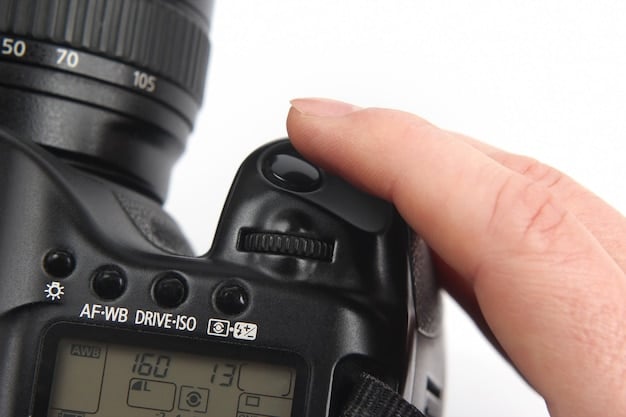
Aperture Priority Mode
Shooting in aperture priority mode (Av or A) allows you to control the depth of field while the camera automatically adjusts the shutter speed. Select a wide aperture (f/2.8 or wider) to maximize light intake and create a shallow depth of field that isolates your subject.
Shutter Speed Strategies
A fast shutter speed (1/200s or faster) is crucial for freezing motion, especially with energetic performers. However, in low light, you may need to compromise and lower the shutter speed to 1/100s or even 1/60s, especially if your lens has image stabilization.
- Shoot in RAW: Capturing images in RAW format gives you more flexibility for post-processing adjustments.
- Understand Your Metering: Pay attention to your camera’s metering mode and adjust accordingly to avoid underexposure or overexposure.
- Practice Makes Perfect: Experiment with different settings at home to get a feel for how they affect your images.
Concert photography is not just about having the right gear and knowing the right setting; it is about being able to adjust as different settings are thrown at you. Mastering the settings makes that possible.
Composing Dynamic Shots in a Chaotic Environment
The energy of a heavy metal concert is infectious, but it also presents a challenge for photographers. Composing dynamic shots amidst the chaos requires a keen eye and quick reflexes. We’ll discuss techniques for finding compelling angles, utilizing leading lines, and capturing the raw emotion of the performance.
Mastering composition techniques is essential to create visually stunning and engaging images. It’s not always easy, especially in the fast-paced environment of a heavy metal show.
Finding Unique Angles
Don’t be afraid to experiment with different perspectives. Try shooting from a low angle to emphasize the performer’s power or from a high angle to capture the entire stage. Look for unusual vantage points that can add interest to your images.
Utilizing Leading Lines
Leading lines can draw the viewer’s eye into the frame and create a sense of depth. Use stage lights, guitar necks, or even the crowd to create leading lines that guide the eye towards your subject.
Composition is key to storytelling. Think about what story you want to tell with your image and use composition techniques to convey that message.
Navigating Venue Restrictions and Obtaining Permissions
Before heading to a gig, its vital that you research the venue’s rules and restrictions regarding photography. Securing a photo pass can greatly enhance your access and photographic opportunities. We’ll guide you through the process of obtaining permissions and navigating potential limitations.
Understanding the rules and regulations is crucial for a smooth and successful concert shoot. Don’t risk getting kicked out or having your equipment confiscated.
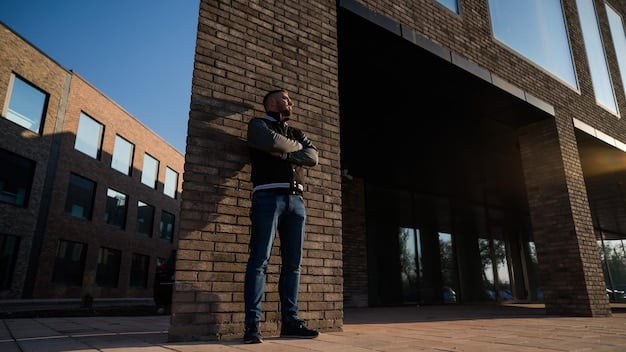
Photo Pass Etiquette
Even with a photo pass, there are certain rules you should follow. Be respectful of the performers and the audience. Avoid using flash photography unless specifically permitted. Stay out of the way of the security personnel.
Building Relationships
Networking with venue managers and band representatives can open doors to future opportunities. Be professional, courteous, and deliver high-quality images. A good reputation can go a long way in the music industry.
- Contact the Venue: Reach out to the venue in advance to inquire about their photography policy.
- Obtain a Photo Pass: If possible, try to get a photo pass from the band or the venue.
- Respect the Rules: Adhere to all venue restrictions and guidelines regarding photography.
Navigating the logistical side of concert photography might be less glamorous than capturing the perfect shot, but it’s just as important. Being prepared and respectful can make a big difference.
Post-Processing Techniques for Concert Photos
Post-processing is an integral part of the concert photography workflow. It allows you to refine your images, correct any imperfections, and enhance the overall impact. We’ll explore essential post-processing techniques for concert photos using software like Adobe Lightroom and Photoshop.
While capturing a great image in-camera is ideal, post-processing can take your photos to the next level. It’s an opportunity to bring out the best in your shots and create a unique artistic vision.
Basic Adjustments in Lightroom
Start by adjusting the exposure, contrast, highlights, and shadows to achieve a balanced tonal range. Pay attention to the white balance and adjust it to accurately reflect the colors of the stage lights.
Noise Reduction Strategies
Since concert photography often involves high ISO settings, noise reduction is a crucial step. Lightroom and Photoshop offer powerful noise reduction tools that can minimize noise without sacrificing too much detail.
- Color Correction: Adjust the colors to accurately represent the stage lighting and enhance the overall mood.
- Sharpening: Apply sharpening to bring out details and add clarity to your images.
- Cropping and Straightening: Crop your images to improve composition and straighten any skewed horizons.
Post-processing is where you can truly express your creativity and put your personal stamp on your concert photos. Use these techniques to develop a unique and recognizable style.
Adaptability and Creative Problem-Solving on the Fly
The best-laid plans can often go awry in the dynamic environment of a live concert. Adaptability and quick thinking are essential skills for any concert photographer. We’ll discuss strategies for overcoming unexpected challenges and seizing opportunities to capture unique and compelling images on the fly.
From sudden changes in lighting to restricted access, you never know what challenges you might face at a concert. Being able to adapt and think on your feet is crucial for success.
Dealing with Unpredictable Lighting
Stage lighting can change dramatically from one moment to the next. Be prepared to adjust your camera settings quickly to compensate for these changes. Use your camera’s histogram to monitor the exposure and avoid clipping highlights or shadows.
Overcoming Obstructions
Crowds, security personnel, and stage equipment can all obstruct your view. Look for creative ways to work around these obstacles. Try shooting from a different angle or using a longer lens to zoom in.
- Stay Alert: Pay attention to what’s happening on stage and anticipate key moments.
- Be Prepared for Anything: Have backup batteries, memory cards, and lenses readily available.
- Don’t Be Afraid to Experiment: Try new techniques and approaches to see what works best in the moment.
Concert photography is a challenging but rewarding field. Embrace the spontaneity and excitement of live music, and let your creativity guide you.
| Key Point | Brief Description |
|---|---|
| 📸 Gear Essentials | Camera body with good high ISO performance and a fast lens (f/2.8 or wider) are crucial. |
| ⚙️ Low Light Settings | Master aperture, shutter speed, and ISO balance for sharp, well-exposed images. |
| 📐 Composition Tips | Find unique angles, utilize leading lines, and capture raw emotion. |
| 🎫 Venue Rules | Research venue rules, get a photo pass, and respect restrictions. |
Frequently Asked Questions
▼
A fast lens (f/2.8 or wider) is ideal. Zooms like a 24-70mm or a 70-200mm offer versatility, while prime lenses (35mm, 50mm) excel in low light with their wider apertures.
▼
Shoot in RAW to retain more detail. Use noise reduction tools in post-processing software (Lightroom, Photoshop) carefully to minimize noise without overly softening the image.
▼
Use aperture priority mode (f/2.8 or wider), a fast shutter speed (1/200s or faster), and adjust ISO as needed. Monitor your histogram and adjust settings as stage lighting fluctuates.
▼
Contact the venue or the band’s management in advance. Build relationships with them by delivering high-quality work consistently, and following venue guidelines.
▼
Usually, no. Flash is often distracting to performers and the audience. The best results come from natural lighting or stage lights. Always confirm before using flash.
Conclusion
Mastering concert photography, particularly in the challenging low-light environment of heavy metal performances, requires a blend of technical skill, creative vision, and adaptability. By understanding your equipment, mastering camera settings, composing dynamic shots, and navigating venue restrictions, you can capture stunning images that truly capture the energy and emotion of the music. Remember to keep learning and improving, and most of all, enjoy the experience!
